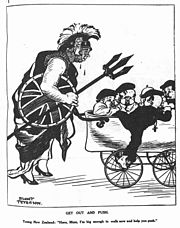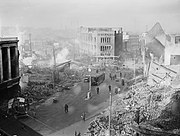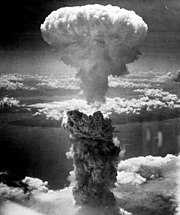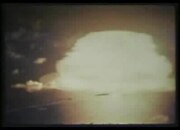Introduction
| New Zealand's Search for Security | ||
|---|---|---|
| Introduction | New Zealand in the post-war period | |
Contents
- 1 New Zealand in the post-war period
- 1.1 The Demise of Great Britain as a global power.
- 1.2 The beginnings of the Cold War between U.S.A. and the U.S.S.R.
- 1.3 Economic vulnerability
- 1.4 Japanese Aggression in the Pacific
- 1.5 Increasing contact with the United States
- 1.6 The emergence of nuclear weapons as a major factor in global relations.
New Zealand in the post-war period
Important issues confronting New Zealand in the post-war period:
The Demise of Great Britain as a global power.
- The Fall of Singapore. The fall of Singapore, one of the biggest defeats in the history of the British Army by the Japanese Army, was on February 15th 1942. The British troops underestimated the Japanese armies, so they were not prepared
- Damage caused by Nazi bombing during the Blitz. The Blitz was the sustained bombing of Britain by Germany. This happened between 7th of September 1940 and My 10th 1941 during world war 2. its intended goal of forcing and demoralising Britain into surrender was not accomplished. The Blitz did little to assist Germany in invading Britain. After the Blitz civilians felt they had an enormous role to play to protect there cities. Many civilians who were not able to join the military became members of the home guard and more importantly the air raid precaution service. The Blitz destroyed hundreds of buildings and many families. This event destroyed British cities but failed to destroy their moral.
- Economy rebuilding as a result of damage suffered during the war effort.
The beginnings of the Cold War between U.S.A. and the U.S.S.R.
Economic vulnerability
Brought about by a reliance on a single (European) market for most of their products. New Zealand main exports were primary products in the 1940s and 1950s.
Japanese Aggression in the Pacific
The psychological damage to the nation caused by Japanese aggression in the Pacific. These acts of aggression included:
- The Japanese Attack on Pearl Harbor. On the 7th of December 1941, the Japanese commenced a surprise attack on the American Navy base of Pearl Harbor. It was a devastating defeat for the American forces, and it is particularly notable that 8 battleships were sunk or damaged. The attack came without a formal declaration of war, and was infamous in the eyes of Franklin D. Roosevelt, who shortly afterwards declared war on Japan and entered WWII. The decisive show of force and the nature of the attack shocked New Zealand, who were forced to face the changing tactics of warfare, where combined navy/air tactics dominated.
- the destruction of the HMS Prince of Wales and the HMS Repulse in Singapore
- the bombing of Darwin and the capture of a Japanese submarine in Sydney Harbour. The bombing of Darwin(19 February 1942) was a Japanese air raid on Darwin initiated about 200 miles Northwest of Darwin. The bombing was lead by the same commander who attacked pearl harbour Mitsuo Fuchid. there were six aircraft carriers involved some of these were Akagi, Kaga, Soryu and Hiryu. In May 1942, Sydney Harbour was attacked by Japanese manned submarines. There were three enemy submarines that entered the harbour and began trying to destroy ally ships. Two of the crews of the submarines committed suicide and the other was not recovered until 2006 where the wreck was found off shore.
- The surveillance of New Zealand by Japanese reconnaissance planes.
Increasing contact with the United States
As a result of U.S. servicemen being stationed in New Zealand.
- Quick information: At any one time between June 1942 and mid-1944 there were between 15,000 and 45,000 American servicemen in camps in New Zealand across New Zealand. Their lives were based in these camps. Camp life must have seemed spartan if you landed directly from the United States (some soldiers were no more than 17 years old), comfortable if you arrived from the heat of a Pacific battle.
- Entertainment: The American soldiers entertainment was based around sport these included crowds of 20,000 watching a baseball game at Wellington's Athletic Park in January 1943, also Boxing tournaments were held, intense competitive games of American football was played on Eden Park in Auckland between the army and the marines. Also In Wellington in mid-1943 an old Wakefield Street building was converted into a gymnasium and sports stadium for basketball and badminton.
The emergence of nuclear weapons as a major factor in global relations.
After the bombing of the Hiroshima and Nagasaki by the United States the world saw the impact and scale of mass destruction a single nuclear bomb can cause. This caused outburst of fears from many countries and was received as a very controversial way to end the war. The sheer power of nuclear bombs was enough to stimulate many countries into developing nuclear weapons. Among these countries were United King, France, the Soviet Union and the People's Republic of China. Countries who posses nuclear weapons quickly rose as very influential powers in their region and caused many international tensions. New Zealand tested Nuclear weapons along with the Americans and the British in Australia. They had not guinea pigs but sacrificial lambs wearing different protective clothing to see if the protective clothing could help against the impact of the nuclear tests.




